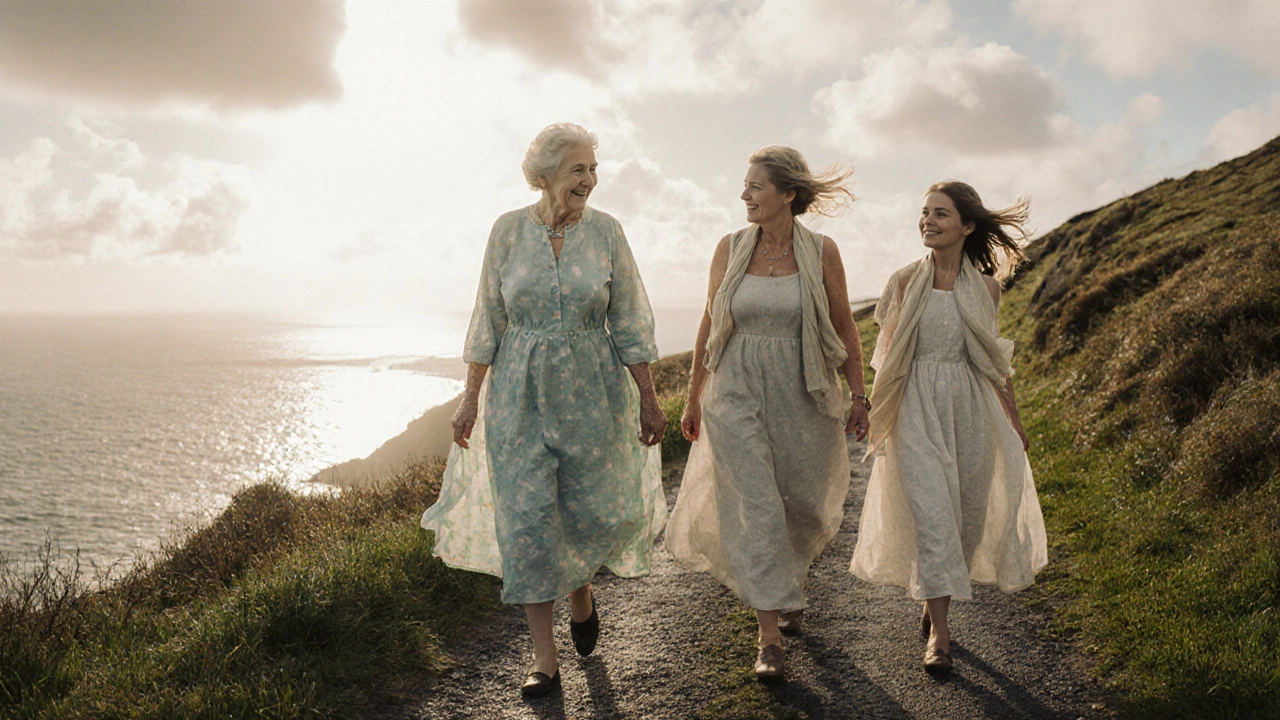Irish Sundress Qualifier
Find out if your dress qualifies as a true Irish sundress based on Ireland's unique climate and style needs.
When you’re standing in a Dublin café on a May morning, wrapped in a light coat while the sun tries its best to break through the clouds, you start to wonder: sundress-what does that even mean here? In Ireland, summer doesn’t arrive with a fanfare. It sneaks in, sometimes barely lasting long enough to dry your laundry. But when it does? You grab the first thing that feels like freedom. That’s where the sundress comes in-not as a beachwear staple, but as a quiet hero of Irish transitional style.
It’s Not About the Temperature, It’s About the Feeling
In the U.S. or Australia, a sundress might mean bare legs, flip-flops, and a day at the beach. In Ireland, it’s different. A sundress here is less about sunbathing and more about feeling light when the air finally loses its chill. Think of it as the dress you wear to a Galway farmers’ market, a picnic in Phoenix Park, or a Sunday walk along the Dingle Peninsula when the wind’s gone quiet for once.
There’s no official rulebook. But if you’ve ever worn a cotton shift dress to a Clifden music festival in July, you’ve already lived the Irish sundress life. It’s not about the length, the sleeve, or the fabric alone-it’s about how it makes you feel. Light. Unburdened. Ready for rain that might come by afternoon but won’t ruin your day.
Key Features of an Irish Sundress
So what makes a dress qualify as a sundress in this damp, unpredictable climate? Here’s what works:
- Lightweight, breathable fabric-cotton, linen, or a cotton-linen blend. Avoid synthetic blends that trap heat and sweat. Irish summers don’t get hot enough to justify polyester.
- Loose fit-no cling. You need room for a light cardigan or a waterproof jacket draped over your shoulders when the sky turns grey.
- Short or midi length-knee-length or just above is ideal. Too short and you’ll be pulling it down on windy cliffs; too long and it gets damp from morning dew on grass.
- Simple, quiet prints-floral patterns are common, but avoid loud tropical prints. Think muted daisies, subtle stripes, or watercolor washes. Dublin brands like Maya & Co. and Clare’s Closet specialise in these.
- Minimal hardware-no heavy zippers, chunky buttons, or metallic details. A tie waist or elastic neckline is better for layering and adapting to changing temps.
One of the most popular styles in Ireland is the shift sundress-a straight-cut, sleeveless or short-sleeved design that hangs loosely from the shoulders. It’s easy to throw on over a long-sleeve tee when the wind picks up, and it works just as well with ankle boots as it does with sandals.
What Doesn’t Count as a Sundress in Ireland
Not every summer dress is a sundress. Here’s what to skip:
- Evening dresses-sparkles, sequins, or structured bodices belong in a Dublin nightclub, not a Wicklow hike.
- Heavy lace or embroidered designs-they look beautiful, but they soak up moisture and take days to dry. You’ll regret it after a sudden downpour in Killarney.
- High-slit or bodycon styles-too restrictive. Irish women don’t dress for the camera. We dress for the walk to the bus stop, the queue at the local bakery, and the possibility of rain.
- Designer beachwear-no one in Ireland wears a sarong over a bikini to the supermarket. Keep the resort vibes for holidays abroad.
Even some dresses sold as ‘sundresses’ in online stores like ASOS or Zara often miss the mark. They’re made for hotter climates. Check the fabric label. If it says ‘100% rayon’ or ‘polyester-spandex’, it’s not built for Irish weather.

Where to Buy Sundresses in Ireland
You don’t need to shop online to find the right one. Local Irish brands understand the climate better than global retailers:
- Maya & Co. (Dublin and online) - Known for breathable cotton dresses in earthy tones, perfect for Dublin’s unpredictable weather.
- Clare’s Closet (Galway) - Handmade linen dresses with subtle floral prints, sold at the Galway Market every Saturday.
- Ardscoil (Cork) - A small sustainable brand using organic cotton and natural dyes. Their ‘Ballycotton Dress’ is a local favourite.
- St. Stephen’s Green Market (Dublin) - Every weekend in summer, local designers set up stalls with one-of-a-kind sundresses made for Irish conditions.
- Primark - Surprisingly, their cotton shift dresses in the summer collection are often the most practical. Simple, affordable, and washable.
Even charity shops like Oxfam or St. Vincent de Paul in Dublin’s Temple Bar or Limerick’s Newtownards Road often have vintage cotton dresses from the 80s and 90s-perfect for the Irish sundress aesthetic. Look for clean seams, no stains, and natural fibres.
How to Style a Sundress for Ireland
Here’s the secret: you don’t need to choose between ‘dressy’ and ‘practical’. In Ireland, you layer.
- Wear a long-sleeve cotton tee underneath if it’s chilly in the morning.
- Throw on a lightweight waterproof jacket-think Mac Coat or Regatta-over your shoulders. It’s not a raincoat; it’s an accessory.
- Swap sandals for ankle boots or loafers. You’ll be walking on wet grass, cobblestones, or muddy trails.
- Carry a small crossbody bag. Not a tote. A sling bag that won’t get soaked if you duck under a pub awning.
- Add a thin scarf in a neutral tone. It doubles as a sun shield and a wind barrier.
At the Galway Races or the Fleadh Cheoil, you’ll see women in sundresses paired with wool cardigans and sturdy shoes. No one laughs. Everyone gets it.

Why This Matters Beyond Fashion
The sundress in Ireland isn’t just clothing. It’s a small act of hope. It’s the dress you put on when you dare to believe the sun will stay out long enough to have tea outside. It’s the garment you wear to the first barbecue of the season, even if the forecast says ‘40% chance of rain’.
It’s also a quiet rebellion against the idea that Irish weather means you can’t dress for joy. You don’t need perfect conditions to feel good. You just need the right fabric, the right fit, and the right mindset.
So when you’re standing in front of your closet in early June, wondering if that floral dress will work-yes. It will. Wear it to the coast. Wear it to the pub. Wear it to the bus stop. Wear it because the sun, for once, is trying.
Frequently Asked Questions
Can you wear a sundress in Ireland in June?
Absolutely. June is the most reliable month for stable weather in Ireland. Temperatures average 15-19°C, with longer daylight hours. A cotton sundress paired with a light jacket works perfectly for daytime events like the Galway Races, seaside walks in Wexford, or outdoor concerts in Cork’s Crawford Art Gallery. Just always carry a foldable rain cover.
Is a sleeveless sundress too cold for Ireland?
Not if you layer. Sleeveless sundresses are common in Ireland during summer, especially when worn over a thin long-sleeve tee or under a cropped cardigan. Many Irish women wear them to weddings, garden parties, or even to work in casual offices. The key is having something lightweight to add when the wind picks up-like a linen shawl or a denim vest.
What’s the difference between a sundress and a summer dress in Ireland?
In Ireland, ‘summer dress’ is a broad term-it can include anything from a linen midi to a printed maxi. A ‘sundress’ is more specific: lightweight, simple, and designed for casual, everyday wear. Think of it as the practical cousin of the summer dress. A sundress doesn’t need to be fancy. It just needs to be comfortable when the weather’s unpredictable.
Are linen sundresses worth it in Ireland’s damp climate?
Yes, but only if you know how to care for them. Linen wrinkles easily and can feel stiff when damp. But it’s also the most breathable fabric for Irish summers. Buy one in a natural colour, avoid heavy dye, and hang it to dry indoors. A quick steam from a kettle or iron on low will restore its drape. Brands like Ardscoil and Clare’s Closet make linen dresses that hold up well with minimal care.
Can men wear sundresses in Ireland?
While not common, gender-neutral fashion is growing in Irish cities like Dublin and Galway. Some men wear lightweight, oversized cotton tunics or wrap-style dresses as part of a casual summer look-especially at festivals like Electric Picnic. It’s not about tradition; it’s about comfort. If it feels right and the fabric works for the weather, it counts.
Final Thought: It’s Not About the Dress. It’s About the Moment.
In Ireland, a sundress isn’t a seasonal trend. It’s a small ritual. It’s the dress you wear when you finally feel like you can breathe again after months of coats and scarves. It’s the dress you throw on before heading out to the pier in Howth, just to see if the sea’s calm. It’s the dress you remember years later-not because it was perfect, but because it was there when the sun showed up.
